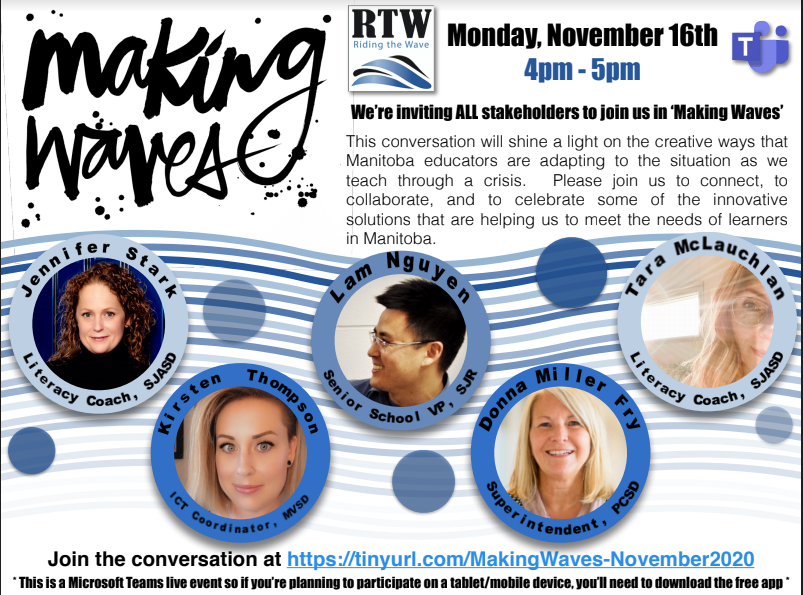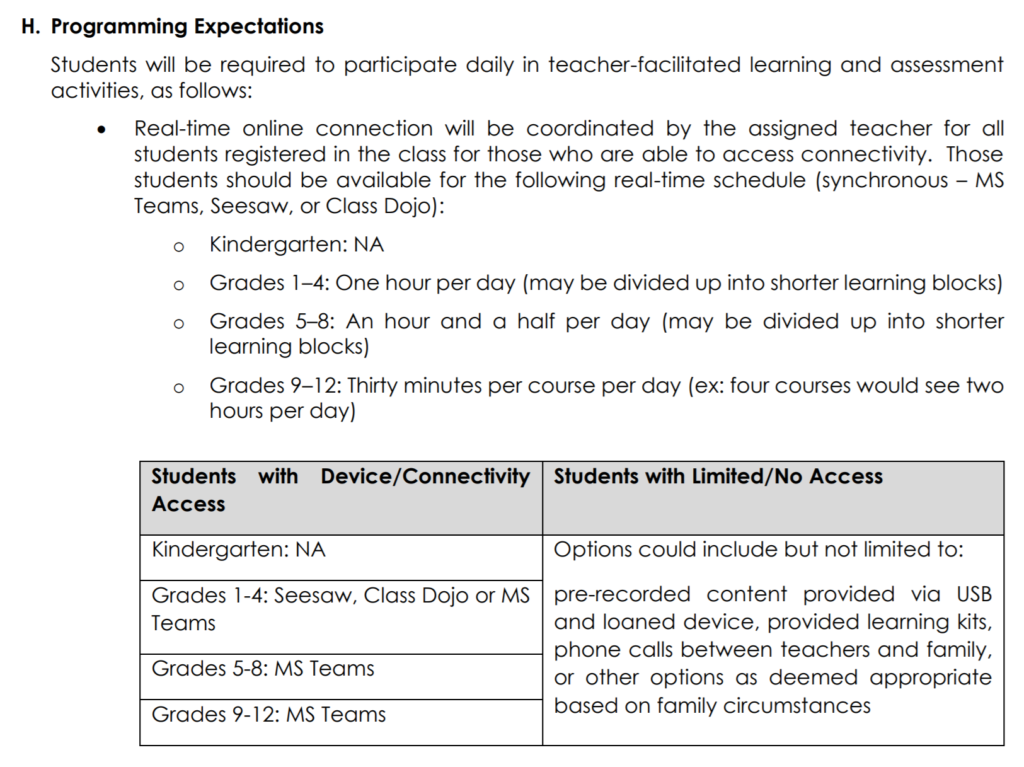Making Waves – MVSD Programming During Covid-19


This information is presented from the divisional perspective. The realities of teaching day-to-day during the Covid-19 pandemic can only effectively be shared from a teacher voice. MVSD has just under 90 accounts, across various social media platforms that share on behalf of their school/classroom/professional position. I invite you to visit these accounts to see a glimpse of what teaching and learning looks like within MVSD and connect with our network. (You can also check out the #mvsd_mb on the platform of your choice)
“Ground Up – Not Top Down”
Our Programs & Planning team consists of our Assistant Superintendent and the following positions:
- Coordinator of Curriculum & Assessment
- Coordinator of Student Services
- Coordinator of ICT
- Coordinator of Library Services
Much of what our team does is the development of divisional policies/procedures and the subsequent staff support as they implement these initiatives. However, I feel that we try to approach all situations with a “ground up” model as opposed to a “top down” model. Our focus is always working to provide our staff with the foundational supports so that they have what they need to implement programming that respects their autonomy and unique teaching scenarios. It is our goal to ensure our staff have the supports they need so that their focus can be on connecting and educating children.
The following initiatives were put in place at a divisional level to help work towards this goal:
- Remote Learning Procedure to clearly outline what this looks like within the MVSD context
- Remote Learning Support Document for staff to provide clarification, practical supports, and detailed examples on how to address each component of the procedure
- Mental Health Resources for students and families
- Included a divisional mental health support phone line during the spring suspension of classes
- Staff supports are also available through our divisional intranet
- Tech Supports for students and families
- Wifi hotspots on the exterior of our school buildings
- Laptop loan program for students who require a device
- Direct tech support platform that connects students/families with platform tutorials and our divisional computer technicians
- Parent/Guardian Tech Training
- In the spring we did weekly Q & A sessions via our divisional Facebook page
- In the fall we hosted in-person and online parent training sessions
- Ed Tech in MVSD YouTube informational channel
- Youth Support Workers to connect families with schools
- A 9-member team who is able to meet with families and outside organizations, conduct home visits, deliver/pick-up school resources, etc
- Remote Learning PD
- Coordinators & coaches have moved some PD online so that teachers can not only access content but witness remote learning pedagogy and strategies in action
The Inequity of Remote Learning
The current Manitoba Education Standards for Remote Learning emphasize online programming with other options, “minimized to the greatest extent possible” (pg. 3).
Connectivity Access
- Manitoba has the 2nd lowest broadband download speeds in Canada at an average 12.6mbps
- Second only to the Yukon
- For reference, a connection of 8mbps is recommended for a one-to-one Teams video call
- Broadband is only available in 5 communities within our catchment area and only for those within town limits
- ~16% of MVSD families communicated with MVSD that they had connectivity that was sufficient for online programming (*this statistic is based on those who completed a survey held by the division; which was not completed by ~half of families)
Sustainability of Access
- Canada has some of the most expensive connectivity costs in the world
- Most data plans in Manitoba start with 10-15GB of data for their monthly plans
- 1hr of Teams meetings is ~225mb of data
- Current minimums require up to 9GB of data just for synchronous video classes (no assignments, YouTube videos, web searches, etc)
More Than Broadcasting – How Does Remote Teaching Differ
There is an assumption that the only difference between in-person teaching and remote teaching is where the students are located. However, remote teaching is not as simple as placing teachers in front of a camera. I like to use the analogy of listening to a podcast or radio narrative compared to listening to the audio of a TV show. Think of how a podcast or radio narrative is designed and presented in a manner to account for a lack of visual cues: descriptive language, use of auditory cues, etc. In the same way that listening to a TV show without the visuals leads to missed information, using in-person strategies remotely can also lead to missed information.
As such, requiring teachers to teach remotely without education on remote pedagogies OR requiring teachers to teach both face-to-face and remote students simultaneously does a huge disservice to both learners and educators.
Some of my recommended resources for Remote Learning PD are:
- Blended Learning MOOC (their textbook is free and accessible for all)
- Remote Learning 101
- Blended Learning Toolkit
Synchronous Across The Grades
MVSD’s Remote Learning Procedure states that our programming expectations emphasizes a reflection of the MB curriculum and includes the following elements: project-based and play-based learning, physical activity, and connections with nature. The following is our synchronous programming expectations:
